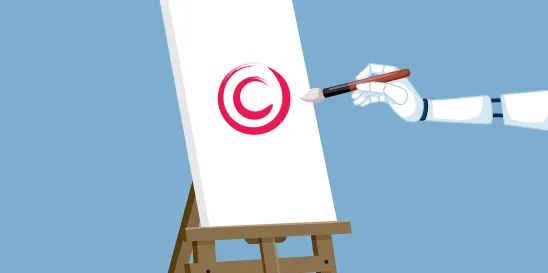The growth of artificial intelligence (“AI”) and generative AI is moving copyright law into unprecedented territory. While US copyright law continues to develop around AI, one boundary has been set: the bedrock requirement of copyright is human authorship. Given this, it is clear in the US, AI alone cannot be an author. This bedrock principle was reinforced in two recent copyright decisions. But unanswered questions abound. For example, how will the Copyright Office address collaborative or joint works between a human and AI? And will this bedrock principle be limited to generative AI, or may it lead to revisiting copyright protection for other technologies where creative decisions are left to machines?
On August 18, 2023, the US District Court for the District of Columbia affirmed the U.S. Copyright Office’s denial of a copyright application for a work created using generative AI due to lack of human authorship (Thaler v. Perlmutter, et. al.). In 2019, Stephen Thaler submitted a copyright application for his visual artwork, “A Recent Entrance to Paradise,” which stated that an AI computer algorithm, the “Creativity Machine,” created the artistic piece. The Copyright Office denied the application because it “lack[ed] the human authorship necessary to support a copyright claim.” The application asserted that the work was created autonomously by the machine and listed the machine as the author. Because Thaler acknowledged the work was not human authored and his claim to the copyright was based only on the fact of his “[o]wnership of the machine,” the Copyright Office denied his application.
In response, Thaler filed a complaint in the district court challenging the denial of his copyright application. Thaler included several new legal theories to suggest that his contribution to the Creativity Machine, such as his ownership and prompting of the software, would establish a human component of authorship. Thaler raised new issues in his complaint by asserting new facts alleging that he “provided instructions and directed his AI to create the Work,” that “the AI is entirely controlled by [him],” and that “the AI only operates at [his] direction.” However, such statements contradicted the application record, which stated that the AI created the work on its own. Because the procedural requirements limited the court’s analysis to those facts stated in the record, the court refused to address whether Thaler’s involvement was sufficient to meet the human authorship requirement. As such, the court disregarded his claims in its decision to affirm the denial of his copyright application.
While the court acknowledged that the Copyright Act was written to intentionally leave open the concept of “original work of authorship” to adapt to changing norms and “technologies developed long after traditional media or writings,” it emphasized that the core of copyrightability is human creativity. The court cited several cases supporting its position that while the Copyright Act has developed over time to protect different mediums of work, the works were always created by human authors, artists, and creators. The court refused to dive into the debate of whether non-human sentient beings may be deemed authors, calling it an “unnecessary detour” in developing the Copyright Act. In response to whether non-human authorship could be covered by the Act, Judge Beryl A. Howell affirmed, “[i]n the absence of any human involvement in the creation of the work, the clear and straightforward answer is the one given by the Register: No.” Where AI alone creates a work, this point seems clear.
Shortly following the Thaler decision, another artistic work created with generative AI was denied copyright protection. The Copyright Office denied protection for Jason Allen’s science-fiction themed artwork “Theatre D’opera Spatial,” which he created with an AI tool called “Midjourney.” The work garnered national attention for being the first AI-generated image to win the 2022 Colorado State Fair’s annual fine art competition. Mr. Allen explained that he “input numerous revisions and text prompts at least 624 times to arrive at the initial version of the image.” In its rejection, the Copyright Office noted that copyright applicants seeking protection for works that contain more than a de minimis amount of AI-generated content must disclaim the AI-generated material. Because Allen refused to do so, the work was not registered. The Copyright Office’s refusal confirmed the bedrock principle that only human works can be protected.
The Copyright Office also dismissed Allen’s other arguments, including that denying copyright protection to AI-generated material leaves a “void of ownership troubling to creators.” According to the Office, the Constitution and the Copyright Act define the works entitled to copyright protection, and expressly exclude certain subject matter. Based on this, the Office concluded that simply because not all works satisfy this standard does not create a “troubling” void of ownership.
Another argument rejected was based on Allen’s suggestion that “fair use” relates to the determination of whether a work is copyrightable. The Office retorted that fair use is a legal doctrine that permits the unauthorized use of copyright-protected works in certain circumstances, but it does not address copyrightability. The Office added that to the extent Allen argues by analogy that his visual edits are “transformative,” and thus, copyrightable, the Board agrees that human-authored modifications of AI-generated material may protected by copyright. It cited its AI Registration Guidance, 88 Fed. Reg. at 16,192–93 noting often “a work containing AI-generated material will also contain sufficient human authorship to support a copyright claim” because a human author may select, arrange, or modify AI-generated material in a sufficiently creative way. But it emphasized that the Office cannot register Allen’s human contributions if he does not limit his claim regarding the AI-generated material.
It also dismissed Allen’s argument that requiring creators to list each tool and the proportion of the work created with the tool would have a burdensome effect. The Office stated that it does not require a detailed disclosure of the specific identity and creative process behind the AI-generated material in a work. Rather, the Office’s guidance merely requires applicants to provide a “brief statement” in the application, such as that the text was “generated by artificial intelligence.”
As issues continue to arise surrounding the role of AI in the creation of artistic works and the development of the Copyright Act, the focus will remain on human involvement in, and ultimate human creative control over, the work. For now, the Thaler and Theatre D’opera decisions illustrate that copyright law has not yet been stretched to protect works generated by new forms of technology “operating absent any guiding human hand.”
Considerations Moving Forward
For now, authors will need to continue to pay close attention to what is human authored and what is AI-generated and adhere to the disclosure and disclaimer requirements mandated by the Copyright Office. Any AI-generated content that is more than de minimis should be explicitly excluded from the application. This duty to disclaim includes AI-generated content in new, pending and issued registrations.
However, in August 2023, the Copyright Office published a Notice of Inquiry as part of its study of the copyright law and policy issues raised by AI and to assess whether legislative or regulatory steps are warranted. Comments can be submitted electronically through regulations.gov until October 18, 2023.
One issue being considered is the scope and level of human authorship, if any, necessary in copyright claims for material produced in whole or in part by generative AI. Two sets of questions relevant to this inquiry are:
- Under copyright law, are there circumstances when a human using a generative AI system should be considered the “author” of material produced by the system? If so, what factors are relevant to that determination? For example, is selecting what material an AI model is trained on and/or providing an iterative series of text commands or prompts sufficient to claim authorship of the resulting output?
- Are any revisions to the Copyright Act necessary to clarify the human authorship requirement or to provide additional standards to determine when content including AI-generated material is subject to copyright protection?
Perhaps this inquiry will lead the Copyright Office to deal with joint authorship between humans and artificial intelligence, e.g., where a human modifies the output from generative AI, or a human guides AI to modify an human generated work that is input to the AI tool.
From a policy perspective, prohibiting protection for collaborations between humans and AI tools may deter use of generative AI for creative works. This seems contrary to the Constitutional mandate to “promote the progress of science and useful arts.”
One potentially significant ramification of the Copyright Office’s current guidance on human authorship is whether it will affect works generated by technology other than AI. While AI was the impetus for the Copyright Office guidance, the requirement for human authorship is not limited to AI-generated works. Some commentators have suggested this inquiry could open works generated by other technology to greater scrutiny.
For example, photographs have long been deemed copyright protectable. The Supreme Court has held since the 1884 case Burrow-Giles Lithographic Co. v. Sarony that photographs can be entitled to copyright protection where the photographer makes decisions regarding creative elements such as composition, arrangement, and lighting. Some advocates of more protection for AI-generated content point to this decision for support arguing that AI programs are analogous to cameras and other tools that humans have used to create copyrighted works. Could this argument backfire?
The Burrows case highlights that a focus is on whether the photographer makes decisions regarding creative elements such as composition, arrangement, and lighting. In the early days of photography, photographers had to make the creative decisions. But as camera technology has progressed, nearly all digital cameras have an “auto mode.” Selecting auto mode empowers your camera to use its best judgement to select settings such as shutter speed, aperture, ISO, white balance, focus and flash to take the best shot it can. Might the Copyright Office (or defendants in a copyright lawsuit) assess whether leaving these aspects of the creative process to the camera technology impact the copyright protection for resulting images as non-human authored? Even if a human makes the creative selections, will using an auto enhance tool for such images, like the magic wand on iOS devices, require disclaimer of the enhancements made to the image?
One can envision various other technologies that are automated and make “creative decisions.”
Will works created with these other technologies come under greater scrutiny for protectability if there is not sufficient human authorship and/or require disclaimers for the non-human portions?
At this point there are more questions than answers. Hopefully, the Copyright Office inquiry will bring greater clarity and strike an appropriate balance of the issues.




 />i
/>i
